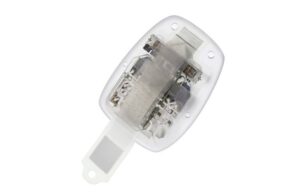
Neuralink co-founder Max Hodak and the Science team unveiled the Science Eye, the company’s brain-computer platform.
Now the Science CEO, Hodak helped start Neuralink, Elon Musk’s venture into brain-computer interfaces (BCIs). He served as president there until 2021. He’s now working on a new brain-computer platform. Contrary to Neuralink and other companies’ platforms, this one doesn’t require an in-skull implant.
The Science Eye is a visual prosthesis. It targets retinitis pigmentosa (RP) and dry age-related macular degeneration (AMD), two forms of serious blindness. The combination device uses an optogenetic gene therapy targeted at the cells of the optic nerve. It combines that with an implanted, flexible thin-film, ultradense microLED display panel inserted directly over the retina.
Hodak, Yifan Kong, Alan Mardinly, Corey Wolin, Emma Zhou and the Science team authored a news release unveiling the platform. They explained that inserting a gene into the cells of the optic nerve makes it possible to stimulate them using the small display. The heavily compressed signal sent down the optic nerve allows the Science Eye to stimulate data into the optic nerve.
Using the Science Eye to restore sight
“Images the first patients will experience might look quite different from what you or I think of as vision,” the team wrote. “This is something we think will improve as we learn more – much of this neuroscience is difficult to do in animals – but even so, we hope to restore significant independence to even our (future) early patients.”
The Science team said it aims to publish a paper demonstrating early functional results in rabbits in the future. The focus now rests on demonstrating safety in animals to eventually lead into a first-in-human clinical study.
“We are working as quickly as we can and hope that commercialization isn’t too far off, but for now it is important to emphasize that the Science Eye is not available for purchase and will not be available until we can satisfy both ourselves and regulators that it is safe and effective, which will take time and further development,” the team said.
Aiming to make ambitions a reality
The team said its hope remains to bring something to the market in the “not too distant future.” However, they highlighted their awareness that claims for the next “bionic eye” have come without results for years.
Science Eye does not represent the first work on visual prostheses, they said. Nor is it the first to the idea of using optogenetics in the optic nerve.
According to the team, the difference comes in the form of the microLED film over the retina. Constant mapping allows for the learning of sophisticated encodings that go beyond basic flashes of light or vague shapes, they explained.
“At Science, we have a broad mandate to follow interesting technical insights wherever they lead us, and are always looking for exceptional scientists and engineers to join our team and help us make our ambitions for a bright future a reality,” the team wrote.